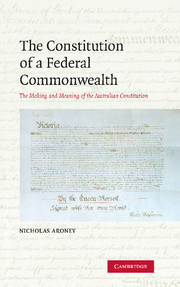Book contents
- Frontmatter
- Contents
- Preface
- Table of statutes and executive instruments
- Table of cases
- Introduction: Australia as a federal commonwealth
- PART I Federalism
- PART II Federating Australia
- PART III Australian federation
- 7 Principles of representation
- 8 Representative institutions
- 9 The states and the Commonwealth
- 10 Configurations of power
- 11 Amendment procedures
- PART IV Conclusions
- Select provisions
- Bibliography
- Index
7 - Principles of representation
Published online by Cambridge University Press: 05 August 2012
- Frontmatter
- Contents
- Preface
- Table of statutes and executive instruments
- Table of cases
- Introduction: Australia as a federal commonwealth
- PART I Federalism
- PART II Federating Australia
- PART III Australian federation
- 7 Principles of representation
- 8 Representative institutions
- 9 The states and the Commonwealth
- 10 Configurations of power
- 11 Amendment procedures
- PART IV Conclusions
- Select provisions
- Bibliography
- Index
Summary
[W]ho are the people whose views we are going to take? The voice of the people must rule, of course, but we want to be sure about what we mean when we talk about the voice of the people.
John Cockburn (1897)Within the philosophical and institutional context outlined in previous chapters, delegates to the conventions of 1891 and 1897–8 drafted Commonwealth Bills for the formation of an Australian federation. The Commonwealth Bills contained representative structures deeply influenced by those formative conditions.
The bills grew progressively out of Andrew Inglis Clark's draft, modified under the leadership of Samuel Griffith in 1891 and Edmund Barton in 1897–8. While important changes were made, Clark's structural framework was largely preserved, particularly the relationship between the formative basis of the proposed federation and the representative institutions, configuration of power and amendment provisions to be adopted. In particular, Clark's scheme for the composition of the Federal Parliament and the structure of the Constitution's text remained largely intact. While later changes moved the Constitution in relatively more nationalist directions, the formative processes through which Constitution came into being constrained that movement significantly.
While these practical constraints limited what was arguable and feasible within the federal conventions of 1891 and 1897–8, there was significant debate about the details, and philosophical factors were prominent. Broadly speaking, there were three main lines of division. The first of these was a division between liberals and conservatives. The basic principle of the liberals was the idea of popular and progressive government. On the liberal view, the people should rule, and this meant a broad franchise and majority rule.
- Type
- Chapter
- Information
- The Constitution of a Federal CommonwealthThe Making and Meaning of the Australian Constitution, pp. 187 - 214Publisher: Cambridge University PressPrint publication year: 2009



